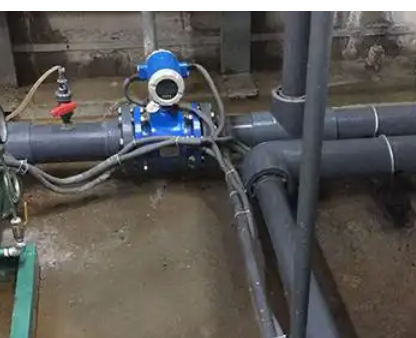



Abstract: As a new type of flow measurement instrument, sewage flow meter has achieved great development in recent years. With its excellent performance and characteristics, it is widely used in the flow measurement of various conductive liquids in the industrial field. It is also used in the measurement of various slurry flows in the food, chemical and water treatment industries. Although compared with other flow meters, sewage flow meter has many advantages, it also has certain defects, that is, it is easily affected by external interference. For this reason, when using sewage flow meter, effective anti-interference measures must be taken, which is of great significance to ensure the accuracy of the measurement results. Based on this point, this paper discusses the interference problem in sewage flow meter.

1. Basic principles of sewage flow meter and analysis of interference sources
1.1 Sewage flow meter measurement principle
The so-called sewage flow meter is essentially an inductive instrument that measures the volume flow of the conductive medium in the pipe according to the Faraday electromagnetic induction law. It mainly uses the embedded technology of single-chip microcomputer to realize digital excitation and relies on the CAN field bus for measurement. From the concept of sewage flow meter, it can be known that its measurement principle is based on the Faraday electromagnetic induction law. When the conductive metal rod moves perpendicular to the direction of the magnetic field line at a certain speed, an induced voltage will be generated. Under normal circumstances, the conductive medium in the measuring tube of the flow meter can be regarded as a conductive metal rod, and the excitation coils at the upper and lower ends will form a relatively uniform constant magnetic field in the vertical direction of the pipeline. When the conductive fluid passes through the pipeline at a specific speed, it will cut the magnetic field lines, thereby generating an induced electromotive force. If electrodes are installed at both ends of the pipeline, the induced voltage can be detected on the electrodes. The signal conversion device in the flow meter can calculate the volume flow of the conductive fluid by measuring the magnitude of the induced voltage, thereby obtaining the actual volume flow through the pipeline. The sewage flow meter consists of two parts: the sensor and the signal converter. The sensor is generally installed in the measured pipeline on site, while the signal converter is mainly responsible for filtering and amplifying the weak signal obtained by the sensor measurement, and converting the signal into a standard output signal, thereby achieving the purpose of display, recording and regulation.
1.2 Analysis of interference sources of sewage flow meter
The flow signal of the converter is provided by the sensor, which is a voltage signal, that is, the potential difference between electrodes. In measurement practice, affected by factors such as electrostatic induction, electromagnetic induction, and electrochemical potential, the voltage on the electrode not only forms an electromotive force proportional to the flow rate, but also contains a variety of interference components, mainly from the following aspects:
1) There are a large number of power frequency signals at the working site of the sewage flow meter, which leads to the power frequency interference noise coupled in the excitation circuit, front-end amplifier, and electrode, seriously affecting the measurement accuracy of the sewage flow meter.
2) The sewage flow meter will produce interference under the action of low-frequency rectangular wave excitation, which is mainly due to the generation of differential interference signals caused by the sudden change of the excitation current. At the same time, the interference signal will gradually disappear as the current stabilizes.
3) The transformer effect on the electromagnetic flow sensor will also produce an orthogonal interference signal that is 90° in phase with the flow signal.
4) Some electromagnetic screens have problems such as poor grounding and shielding, stray capacitance, etc., which can easily lead to unbalanced return current, thus causing common mode interference and even causing potential changes in some circuits. This is one of the important factors causing zero drift of sewage flow meters. In this case, the high radiation electric field generated will continuously deteriorate electromagnetic compatibility.
5) If the circuit board design does not fully consider electromagnetic compatibility, it will cause cross-mode interference, which will lead to a decrease in signal quality, especially for analog circuits and high-speed routing, which will cause serious adverse effects.
6) Under the action of the induced electric field, the electrolyte in the measured liquid will produce polarization phenomenon on the electrode surface, forming electrochemical polarization electromotive force interference, which will cause the sewage flow meter to drift zero.
2. Effective measures for sewage flow meter anti-interference
2.1 Measures to combat orthogonal interference
The so-called orthogonal interference specifically refers to interference that is 90° out of phase with the flow signal. When the transmitter of the electromagnetic force meter operates in AC excitation mode, an alternating magnetic field is formed, and the closed circuit is in this magnetic field. Since the closed circuit cannot be parallel to the magnetic lines of force generated by the alternating magnetic field of the sewage flow meter transmitter, a part of the alternating magnetic lines of force will pass through the closed circuit, which will form an interfering electromotive force in the loop. In order to effectively suppress or eliminate the influence of orthogonal interference on the sewage flow meter, measures can be taken from the two parts of the transmitter and the signal converter. The specific contents are as follows:
1) Take anti-interference measures on the transmitter. The plane of the closed loop should be kept parallel to the alternating magnetic lines of force as much as possible, so as to prevent the magnetic lines of force from passing through the closed loop. At the same time, an interference adjustment mechanism can be set to reduce interference signals. In addition, a zero adjustment potentiometer can be set on the transmitter, through which the potentials of the currents generated in the two loops can be offset, thereby achieving the purpose of eliminating orthogonal interference signals.
2) Take anti-interference measures from the signal converter. An anti-interference mechanism can be set in the converter to eliminate the residual orthogonal interference signal in the transmitter. The specific method is to set a mechanism to compensate and suppress orthogonal interference at the output end of the main amplifier.
2.2 Software Anti-interference Technology
In EPROM, the solidified software and hardware of the sewage flow meter must not only ensure the realization of the normal functions of the sewage flow meter, but also must have strong fault tolerance and anti-interference capabilities to build a fully functional application program.
1) Digital filtering technology. This technology is widely used in intelligent instruments and has functions that analog filters do not have, including eliminating pulse interference, improving the power frequency resistance of A/D converters, eliminating burr interference in digital circuits, and ensuring the reliability of digital input to microprocessors.
2) Program-controlled amplifier technology. This technology can solve the problem of automatic conversion of sewage flow meter range. Through gain control, it can achieve the purpose of weakening the amplifier overload caused by the differential interference peak, which is conducive to processing the flow signal potential and enhancing the ability to resist differential interference.
2.3 Synchronous sampling anti-interference technology
When the signal is continuous, synchronous sampling technology can be used for sampling. However, it must be noted that the selected sampling area, symmetry, width, and starting point will make it difficult for the sewage flow meter to achieve measurement accuracy under the influence of small flow. For this reason, the sampling frequency should be selected as an integer multiple of the power frequency cycle. This approach can ensure that when the sampling time mixed with interference signals is the power frequency cycle, it is free from voltage interference.
2.4 Grounding anti-interference measures
Normally, the anti-interference ability of the sewage flow meter will be reduced due to the small output signal of the transmitter, so the zero potential of the transformer input circuit should be grounded separately, which can not only play a shielding role, but also effectively reduce the influence of the electromagnetic field interference of the excitation system itself. In addition, the sewage flow meter grounding must be selected away from large electrical appliances to prevent current from entering.